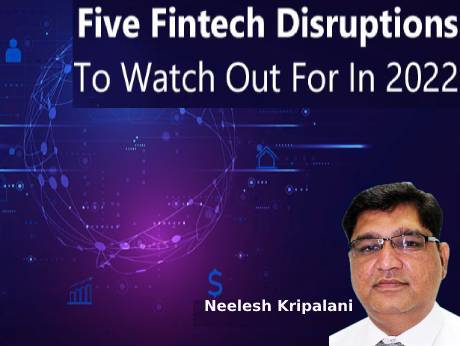
Tech in 2022 - 1
We begin today a series of articles by industry experts, on what to expect in 2022, across the spectrum of information technology.
By Neelesh Kripalani, Chief Technology Officer, Clover Infotech, a leading IT services and consulting company, based in Bangalore
December 20 2021: Fintech involves the efficient use of technology to simplify financial processes in a company and to build efficiency and automation in transactions, payments processing, etc.
However, Fintech has further evolved to disrupt our ways of life. It has provided the much-needed convenience with respect to transaction, payments, savings, investments, and insurance.
Here’s a list of the key trends that we can see in Fintech:
Digital only banks powered by mobile banking: Taking banking to the last mile has been a challenge that many developing nations have been trying to address. With the advent of the smartphone and digital transactions, banking needn’t be necessarily done through a branch. Windowless banking is increasingly seeing adoption. Even processes as complicated as a KYC can now be done digitally through video and so can activities such as account opening, transactions, fund transfers, utility bill payments, etc.
Blockchain to reduce cost per transaction and enhance convenience: Financial Services firms are now using Blockchain, which is a distributed-ledger technology. By using blockchain enabled transactions, financial services providers can now lower the cost of cross-border remittances and money transfers. Blockchain also enables to ensure that records are not tampered with and hence can find application in financial compliances, trading of securities, etc. It also facilitates a method of transaction using digital currencies, which offers a very secure payment method while driving down the cost of transaction, handling of cash etc.
The rise of CBDCs to augment financial inclusion and make payments ubiquitous: As digital payment systems and infrastructure is increasingly becoming robust, central banks around the world are keen to consider rolling out of Central Bank Digital Currencies (CBDCs). CBDCs can enable the banks to not only enhance digital payments but also facilitate ease of payments at the very last mile. It can also help the central banks to reduce the cost, effort, and time spent on printing currencies, managing physical money, and spending efforts towards surveillance and keeping track of counterfeit notes etc.
The advantage of digital currencies is that they are available ubiquitously i.e., as and when a customer needs it. It can also circumvent the middlemen who come in with cash transactions and can also prevent nefarious activities around money transfers and remittances while lowering cost of remittance.
Data driven Micro-lending: We live in an era where more people have mobile phones than bank accounts or a credit history that can be reliably used to underwrite.
Hence, data driven micro-lending has taken centerstage. With apps and micro-credit, fintech companies can now gauge the behavior and spending patterns of customers and underwrite in a very customized fashion. They may not even require a bank statement or a credit score to tap these customers – many of whom are new to credit.
This is where the power of mobile interfaces, immersive customer experiences, and data analysis comes in to enable fintech companies to underwrite well and disburse micro-loans digitally to the remotest of villages in the country.
Insurtech startups: Among the disruptors in financial services are also insurtech companies. By leveraging the power of mobile and internet connectivity, they are enabling to enhance the penetration of insurance services to the last mile. Some of these startups claim to have created seamless processes and incorporated automation wherever possible. This has ensured that customers can receive their quotes, renew their policies, pay premium and even avail claims in a matter of a few seconds.
The disruptions that we have witnessed so far in Fintech is just the beginning. We are being ushered into an era of contactless payments, discount broking, minimum fee-based wealth management models, and super-fast delivery of insurance products, etc. These disruptions are significant, however there’s much more to follow in the coming years.